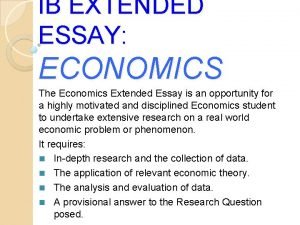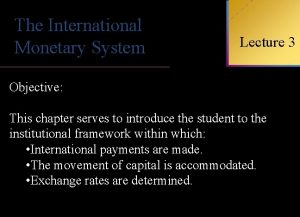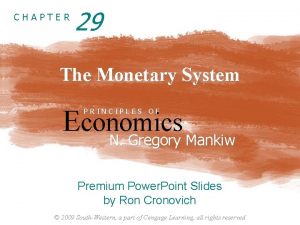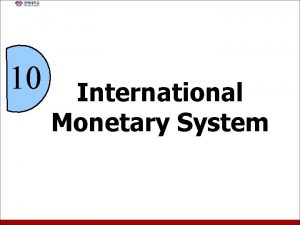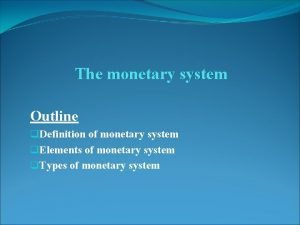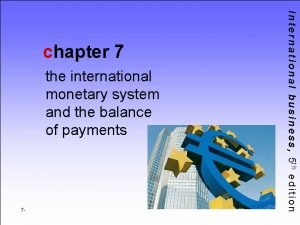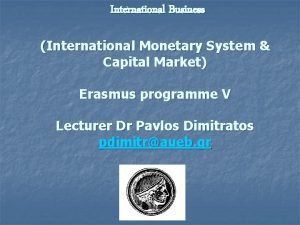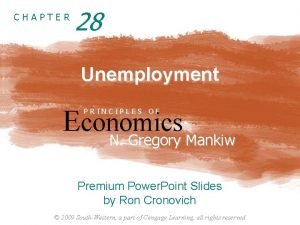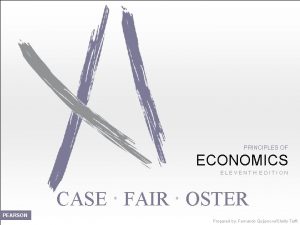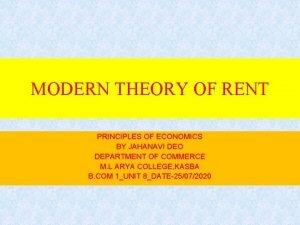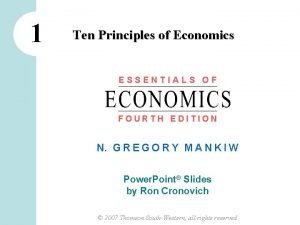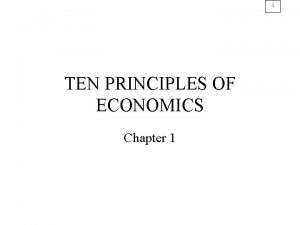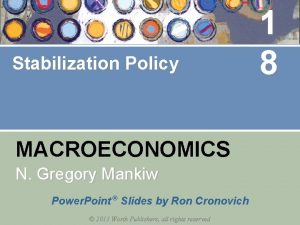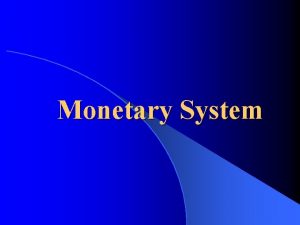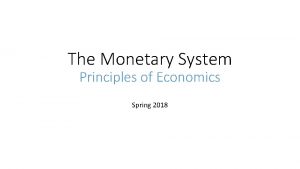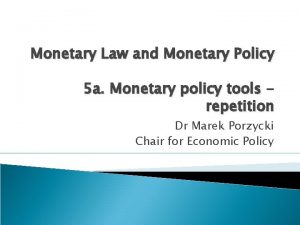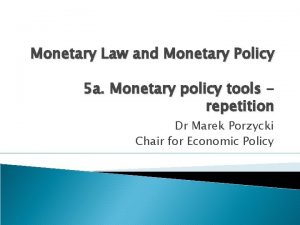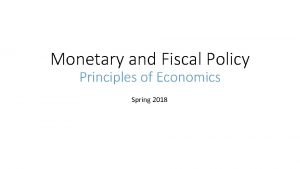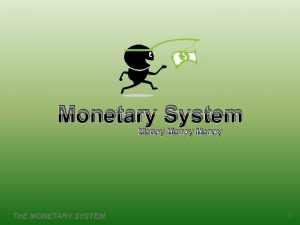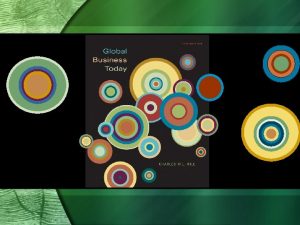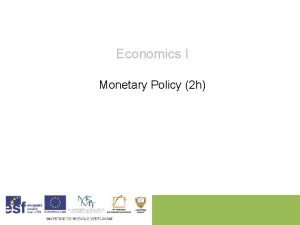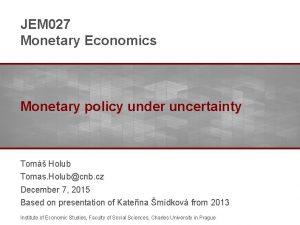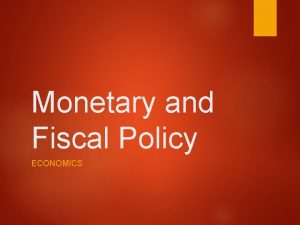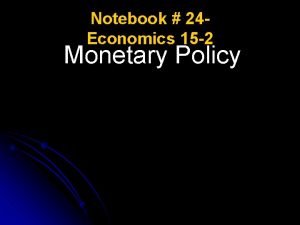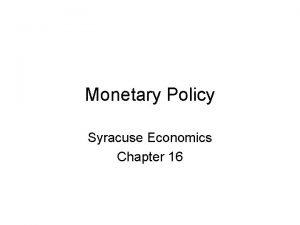The Monetary System Principles of Economics Spring 2018




















- Slides: 20

The Monetary System Principles of Economics Spring 2018

What Money Is and Why It’s Important • Money is the set of assets in an economy that people regularly use to buy goods and services from other people. • Three Functions of Money • Medium of exchange: an item buyers give to sellers when they want to purchase g&s • Unit of account: the yardstick people use to post prices and record debts • Store of value: an item people can use to transfer purchasing power from the present to the future

Measures of Money Supply • M 1: currency, demand deposits, traveler’s checks, and other checkable deposits. M 2: everything in M 1 plus savings deposits, small time deposits, money market mutual funds, and a few minor categories. Money supply in China: http: //www. pbc. gov. cn/diaochatongjisi/resource/cms/2018/05/201805171437 5515903. htm The distinction between M 1 and M 2 will often not matter when we talk about “the money supply” in this course.

Banking System • Commercial Banks • All financial intermediaries (chartered banks, trust companies, credit unions, etc. ) • Central Bank (i. e. the People’s Bank of China) • An institution that oversees the banking system and regulates the money supply • Monetary policy • The setting of the money supply by policymakers in the central bank

Bank Reserves • In a fractional reserve banking system, banks keep a fraction of deposits as reserves and use the rest to make loans. • The Fed establishes reserve requirements, regulations on the minimum amount of reserves that banks must hold against deposits. • Banks may hold more than this minimum amount if they choose. • The reserve ratio, R = fraction of deposits that banks hold as reserves = total reserves as a percentage of total deposits 中国存款准备金率: 大型金融机构(2018年 4月调整后): 16%;中小金融机构: 14%.


Bank T-Account • T-account: a simplified accounting statement that shows a bank’s assets & liabilities. • Example: FIRST NATIONAL BANK Assets Liabilities Reserves $ 10 Deposits $100 Loans $ 90 § Banks’ liabilities include deposits, assets include loans & reserves. § In this example, notice that R = $10/$100 = 10%.

Banks and the Money Supply: An Example Suppose $100 of currency is in circulation. To determine banks’ impact on money supply, we calculate the money supply in 3 different cases: 1. No banking system 2. 100% reserve banking system: banks hold 100% of deposits as reserves, make no loans 3. Fractional reserve banking system

Banks and the Money Supply: An Example CASE 1: No banking system Public holds the $100 as currency. Money supply = $100.

Banks and the Money Supply: An Example CASE 2: 100% reserve banking system Public deposits the $100 at First National Bank (FNB). FNB holds 100% of deposit as reserves: FIRST NATIONAL BANK Assets Liabilities Reserves $100 Deposits $100 Loans $ 0 Money supply = currency + deposits = $0 + $100 = $100 In a 100% reserve banking system, banks do not affect size of money supply.

Banks and the Money Supply: An Example CASE 3: Fractional reserve banking system Suppose R = 10%. FNB loans all but 10% of the deposit: FIRST NATIONAL BANK Assets Liabilities Reserves $100 10 Deposits Loans $ 90 0 Depositors have $100 in deposits, borrowers have $90 in currency. Money supply = C + D = $90 + $100 = $190 (!!!)

Banks and the Money Supply: An Example CASE 3: Fractional reserve banking system How did the money supply suddenly grow? When banks make loans, they create money. The borrower gets – $90 in currency—an asset counted in the money supply – $90 in new debt—a liability that does not have an offsetting effect on the money supply A fractional reserve banking system creates money, but not wealth.

Banks and the Money Supply: An Example CASE 3: Fractional reserve banking system Borrower deposits the $90 at Second National Bank. Initially, SNB’s T-account looks like this: SECOND NATIONAL BANK Assets Liabilities Reserves $ 90 9 Deposits Loans $ 81 0 If R = 10% for SNB, it will loan all but 10% of the deposit.

Banks and the Money Supply: An Example CASE 3: Fractional reserve banking system SNB’s borrower deposits the $81 at Third National Bank. THIRD NATIONAL BANK Initially, TNB’s Assets Liabilities T-account 81 Deposits $ 81 looks like this: Reserves $ $8. 10 $72. 90 Loans $ 0 If R = 10% for TNB, it will loan all but 10% of the deposit.

Banks and the Money Supply: An Example CASE 3: Fractional reserve banking system The process continues, and money is created with each new loan. In this Original deposit = $ 100. 00 example, FNB lending = $ 90. 00 $100 of SNB lending = $ 81. 00 reserves TNB lending = $ 72. 90 generates. . . $1000 of money. Total money supply = $1000. 00

The Money Multiplier • Money multiplier: the amount of money the banking system generates with each dollar of reserves • The money multiplier equals 1/R. • In our example, R = 10% money multiplier = 1/R = 10 $100 of reserves creates $1000 of money

How the Central Bank Influences the Reserve Ratio • reserve ratio = reserves/deposits, which inversely affects the money multiplier. • The central bank sets reserve requirements: regulations on the minimum amount of reserves banks must hold against deposits. Reducing reserve requirements would lower the reserve ratio and increase the money multiplier.

How the Central Bank Influences the Reserve Ratio • Open-Market Operations (OMOs): the purchase and sale of government bonds by the central bank. – If the central bank buys a government bond from a bank, it pays by depositing new reserves in that bank’s reserve account. With more reserves, the bank can make more loans, increasing the money supply. – To decrease bank reserves and the money supply, the central bank sells government bonds.

How the Central Bank Influences the Reserve Ratio • The central bank makes loans to banks, increasing their reserves. – Traditional method: adjusting the discount rate—the interest rate on loans the central bank makes to banks—to influence the amount of reserves banks borrow • The more banks borrow, the more reserves they have for funding new loans and increasing the money supply.

Interest Rate Setting in the US
 Four seasons korean movie
Four seasons korean movie Fall months
Fall months Dada la siguiente secuencia rusia 2018 rusia 2018
Dada la siguiente secuencia rusia 2018 rusia 2018 Ib economics ee sample
Ib economics ee sample International monetary system
International monetary system Chapter 29 the monetary system answers
Chapter 29 the monetary system answers Objectives of international monetary system
Objectives of international monetary system Monetary system definition
Monetary system definition International monetary system
International monetary system International monetary system
International monetary system Economics and business economics maastricht
Economics and business economics maastricht What is mathematical economics
What is mathematical economics Principles of economics oxford fajar
Principles of economics oxford fajar Principles of economics chapter 28 answers
Principles of economics chapter 28 answers Principles of economics powerpoint lecture slides
Principles of economics powerpoint lecture slides Principles of economics case fair oster
Principles of economics case fair oster One of the ten principles of economics in chapter 1
One of the ten principles of economics in chapter 1 Rent principles of economics
Rent principles of economics One of the ten principles of economics in chapter 1
One of the ten principles of economics in chapter 1 Ten principles of economics chapter 1
Ten principles of economics chapter 1 Principles of economics mankiw 9th edition ppt
Principles of economics mankiw 9th edition ppt



